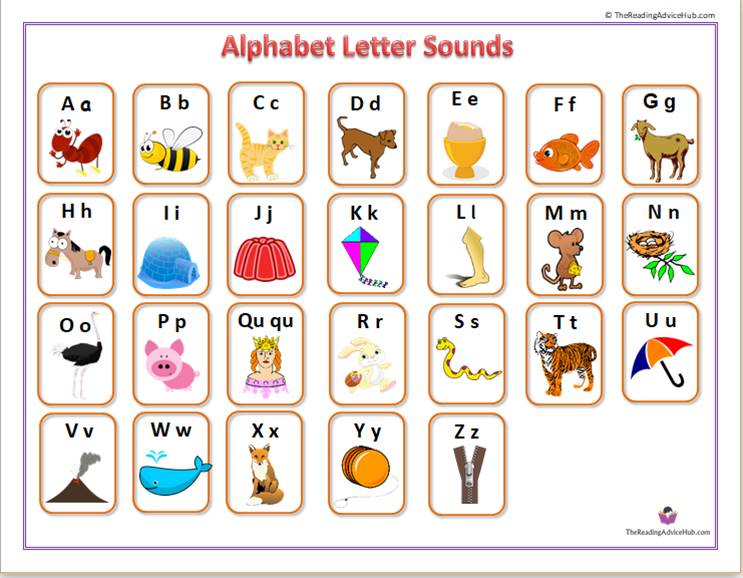Contents:
- What is The Alphabetic Principle or Code in Phonics?
- What is The Basic/Simple Alphabetic Code?
- What is The Advanced/Complex Alphabetic Code?
- Why is the alphabetic principle important?
- Is the Alphabetic Principle Part of Phonemic Awareness?
- What is the Difference Between the Alphabetic Principle and Phonics?
- How to Teach the Alphabetic Code/Principle
What is the Alphabetic Principle or Code in Phonics?
The definition of the alphabetic principle in phonics is that the letters in printed words represent sounds in spoken language.
The alphabetic code (also known as the phonemic code) is the relationship between individual letters of the alphabet (or groups of letters) and the smallest units of sounds in spoken language. These relationships are sometimes called letter-sound correspondences.
The 26 letters of the alphabet and the thousands of words made up by them are actually a set of symbolic coded instructions about spoken language. When we read, our brains need to make sense of this visual coded information and convert it into something that represents spoken language.
The code is reversible, so when we spell, we are converting spoken sounds into the written symbols we call letters.
In phonics instruction, the speech sounds are sometimes described as phonemes and individual letters, or combinations of letters, are described as graphemes.
Educators sometimes separate the alphabetic code into two parts – the basic (simple) code and the advanced (complex) code…
What is the Basic/Simple Alphabetic Code?
The basic or simple alphabetic code contains the most common spellings for the spoken sounds in English.
There are over 40 speech sounds in the English language and most of them can be spelled in several different ways. For example, notice the variation in the spelling of the /f/ sound in the following words: fox, stuff, dolphin, cough.
Teaching beginning readers all the variations at the start would be overwhelming, so phonics teachers often start off by just teaching the most common spelling for each sound.
Basic Alphabetic Code Examples
Teachers might start off by introducing children to the sounds most frequently associated with the individual letters of the alphabet, as illustrated in our alphabet letter sound sheet below.

Some of the common digraphs might also be included as part of basic alphabet code instruction.
The short Alphablocks video below provides a child-friendly introduction to the basic alphabetic code:
What is the Advanced/Complex Alphabetic Code?
There are well over a hundred different spellings for the various sounds in spoken English and some spellings can represent more than one sound. Collectively, these letter-sound correspondences can be described as the advanced or complex alphabetic code.
Phonics teachers introduce the advanced code once children have demonstrated a reasonable grasp of the basic code. However, the alternative spellings are normally drip-fed over a period of many weeks or months to avoid cognitive overload.
Advanced Alphabetic Code Examples
The sound spoken at the start of the word ‘ship’, is often represented as /sh/ in phonics programmes or as (ʃ) in the international phonetic alphabet. This can be spelled (or coded) in a variety of ways in common words:
wash, sugar, tissue, station, racial, chef, ocean
The /or/ (ɔ:) sound can also be represented in a number of ways in different words:
horse, claw, August, store, stalk, taught, bought, four
We’ve produced a table with examples of the different spellings for the 44 Phonemes in English and a comprehensive English Alphabetic/Phonemic Code Chart that you can download for free.
Oxford Owls have a very good Phonics audio guide to the alphabetic code if you want to listen to the sounds associated with the different spellings.
Why is the alphabetic principle important?
The alphabetic principle is the foundation of the English writing system. In fact, it’s the key idea that underpins all phonetic writing systems – ones that use printed letters or symbols to represent sounds in words.
Phonics instruction shows children how to use the alphabetic code to decode print so they can identify words. Also, once children are able to segment spoken words into their constituent sounds, they can use the alphabetic code to spell the words.
In short, knowledge of the alphabetic code is essential for proficient reading and writing.
Is the Alphabetic Principle Part of Phonemic Awareness?
The two ideas are related but phonemic awareness is an auditory skill that can be practised without any reference to printed words.
The alphabetic principle involves understanding the link between the phonemes in spoken words and the letters in written words. So, the alphabetic principle can only be taught in the context of written letters and words.
We discuss questions related to this one in our article on phonological awareness.
What is the Difference Between the Alphabetic Principle and Phonics?
The alphabetic principle is the concept that letters represent spoken sounds. Phonics is a method of teaching this idea to help children learn to read.
How to Teach the Alphabetic Code/Principle
To fully grasp the alphabetic code, children need to learn the letter sounds and understand how they relate to printed words.
We explain how you can teach the letter sounds in our phonics article.
We’ve also compiled a variety of free online games that can help children learn the letter sounds in a fun and engaging way.
Segmenting spoken words and then writing them or constructing them with letters is one of the most effective activities for helping children grasp the alphabetic code. See spelling with magnetic letters or alphabet cards in our article on spelling.
See also ‘What Order Should Letters of the Alphabet and Phonemes Be Taught?’ in our article on letter-sound correspondences.
You might find it helpful to read our article about teaching digraphs, as these are an important part of the alphabetic code.